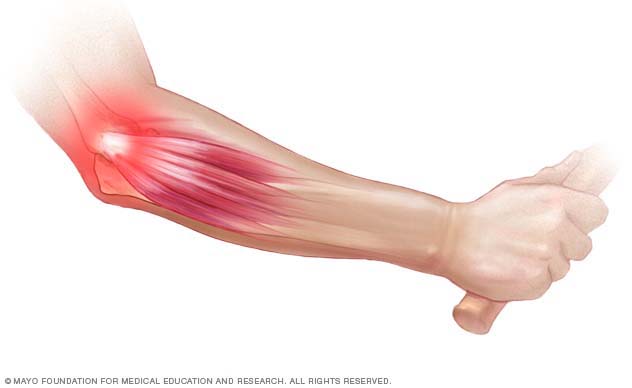 What is Tennis Elbow?
What is Tennis Elbow?
Tennis Elbow, or Lateral Epicondylitis, is a painful condition that affects the elbow. It is inflammation of the tendons of the forearm muscles that attach to the bony outer part of the elbow called the lateral epicondyle.
Causes
This condition can develop from playing tennis as the name implies or from repetitive motions of wrist and/or forearm such as gripping. Overtime, overuse of the forearm muscles cause them to strain and weaken placing stress on the tendons which eventually leads to inflammation and microscopic tears of the tendons.
Symptoms
Patients with this condition often complain of pain, tenderness, or burning in the outer part of the elbow. The pain can sometimes radiate up into the arm or down into the forearm and wrist. Pain usually worsens with activities such as lifting an object, making a fist, knitting, gripping objects, turning a wrench, or shaking hands.
Diagnosis
Your physician and/or physical therapist may conduct various tests to confirm or rule out the diagnosis of Tennis elbow. This includes applying pressure to the affected area and performing special tests including movement of the wrist/elbow to provoke or alleviate symptoms. After a complete physical examination, your physician may order additional imaging tests to confirm the condition or rule out other conditions such as X-rays, MRI, or EMG.
Treatment
According to the literature 80-95% of patients improve pain with non-surgical interventions. Tennis elbow can heal on its own. However, if pain persists or to speed up recovery, it’s recommended to follow the following steps:
- Rest: the first step to help decrease pain and inflammation by holding off on any and all activities that cause pain and involve wrist, hand, and elbow motions.
- Ice: apply a cold pack or massage an ice cube over the affected area for 5 to 10 min and repeat as needed.
- Brace: there are many braces that can be worn below the elbow or at the wrist to restrict repetitive motions to decrease tension on the tendon to allow healing to take place.
Steroid injection: an anti-inflammatory medication injected into the joint to help decrease pain/symptoms and inflammation. However, it may not help in the long term according to the literature.
Surgical treatment: In severe cases of tennis elbow where the pain doesn’t resolve in 6 to 12 months of conservative treatment as included above, surgery may be required.
Enter the Physical Therapist…
If pain continues or worsens, it’s best to visit a physical therapist who can help stretch and strengthen the appropriate muscles. They can also apply modalities to help decrease pain and swelling such as IASTM, ultrasound, kinesio taping, cupping, and electrical stimulation.
Experiencing symptoms as described above? Click below to download a sample exercise program designed specifically for Tennis Elbow.

